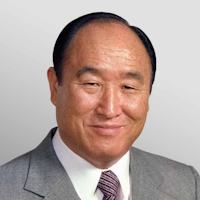We each have both a mind and a body. When the mind and body are united, we do not feel distress… We feel joy.
Sun Myung Moon

Mind and Body
Topic: Self-Cultivation & Health
We each have both a mind and a body. When the mind and body are united, we do not feel distress. But when the mind and body are disunited, when they are not balanced horizontally, we feel inner torment. The problem arises when either the mind or the body is too overpowering, creating an imbalance. When the mind and body are balanced in horizontal alignment, however, we do not feel anxiety. Also, when the mind and body are aligned with the perpendicular, things begin to move. A lively motion ensues, and we feel joy. That is why everything should be aligned with the perpendicular. The horizontal and the vertical must always be in harmony, joining on the perpendicular.
Sun Myung Moon (born January 6, 1920, in Jeongju, in what is now North Korea – died September 3, 2012, in Gapyeong, South Korea) was a Korean religious leader, entrepreneur, and founder of the Unification movement. Raised in a rural Confucian-Christian household during the Japanese occupation of Korea, Moon’s early life was shaped by hardship, devotion, and a strong sense of spiritual calling. As a teenager, he experienced a profound vision in which he believed Jesus commissioned him to complete the work of restoring humanity to unity with God. This revelation became the foundation of his lifelong ministry, devoted to the ideal of universal peace and the healing of the relationship between the divine and human families.
In 1954, after enduring persecution and periods of imprisonment under both Japanese and communist authorities, Moon founded the Holy Spirit Association for the Unification of World Christianity in Seoul. His teachings—later presented systematically in the Exposition of the Divine Principle—offered a reinterpretation of Christian theology emphasizing God’s parental love, human responsibility, and the sanctity of marriage and family. Central to his vision was the belief that love is the creative force of the universe and that humanity’s purpose is to build a world reflecting the oneness of God’s heart. Through international missions, interfaith dialogue, and mass wedding ceremonies symbolizing global reconciliation, Moon sought to transcend divisions of race, religion, and nationality.
Beyond his religious work, Moon established numerous organizations in education, media, culture, and humanitarian service, aiming to foster dialogue, moral renewal, and peace. He and his wife, Hak Ja Han Moon, were regarded by followers as the “True Parents,” embodying the ideal of restored unity between men and women, heaven and earth. While his movement inspired both devoted commitment and significant controversy, Moon’s influence on global religion, culture, and peace initiatives remains substantial. His life reflected an unwavering pursuit of the vision of one human family under God—a vision he advanced with conviction, discipline, and enduring faith in the transformative power of divine love.
Reverend Moon's teachings went beyond the realm of the spiritual to touch on the universal human themes of love and family. He emphasized the importance of nurturing strong, loving families as the cornerstone for a harmonious and peaceful world. To this end, he conducted mass wedding ceremonies known as the 'Blessing', symbolizing the unity of all people under God, regardless of their cultural or religious backgrounds. Moon also stressed the value of community service and encouraged his followers to actively contribute to their local communities.
Sun Myung Moon's partner in both life and work was his wife, Hak Ja Han Moon. As co-leader of the Unification Church, she is a pivotal figure in spreading their shared vision of a world unified by love and peace. Affectionately known as 'True Mother', she embodies the ideal of nurturing and unconditional love in their teachings. After Reverend Moon's passing in 2012, Hak Ja Han Moon assumed sole leadership of the Unification Church and changed the name to Heavenly Parent's Holy Community. In her leadership role, she has tirelessly carried forward their mission, upholding the church's emphasis on peace, interfaith dialogue, and strong, loving families. Under her guidance, the church has continued to flourish, spreading its message of unity and love to people around the globe.
Cheon Seong Gyeong
Moon, Sun Myung, and Hak Ja Han Moon. Cheon Seong Gyeong. Seonghwa Chulpansa, 2015, pp. 371-372 [Cheon Seong Gyeong (212-293, 1991.01.08), Book 4 - True Person, Chapter 1].

Sun Myung Moon
Theme: Healing

About This Sun Myung Moon Quotation [Commentary]
Sun Myung Moon’s quotation, “We each have both a mind and a body. When the mind and body are united, we do not feel distress… We feel joy,” emphasizes the essential harmony needed within ourselves. Moon teaches that the mind and body are meant to function as a unified whole, where the mind guides the body. This alignment is not just physical but also spiritual and emotional, leading to a natural sense of peace and well-being when achieved.
The context of Moon’s statement further explains that imbalance between the mind and body leads to inner turmoil. When one overpowers the other, it disrupts the harmony necessary for peace, manifesting as anxiety or discomfort. Healing, in this sense, is the restoration of balance—a process where both the mind and body return to their proper roles, fostering a deeper sense of joy.
Moon also highlights the importance of aligning the mind and body with the “perpendicular,” symbolizing true love and universal principles. This vertical alignment connects us within ourselves and with the divine. Healing, then, is not just the absence of distress but the cultivation of a life where the mind and body work together, guided by love and higher principles, leading to lasting joy and spiritual fulfillment.
Selection of Related Passages about Mind and Body
Resources
Related Quotes
Copyright © 2017 – 2025 LuminaryQuotes.com About Us